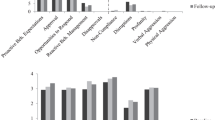Abstract
The current study used a shaping procedure to teach three preschool-aged children diagnosed with autism spectrum disorder to make eye contact with the instructor for a duration of 3 s. Then, eye contact was taught during breaks in instruction. Following the initial intervention, the frequency of reinforcement was decreased while training for generalization across instructors and locations. All three children acquired quick and sustained eye contact, which maintained after 1 month without the need for prompting. This study provides an alternative method for teaching young children diagnosed with autism spectrum disorder to make eye contact without the need for prompting; outlines an approach for teaching eye contact when baseline levels of eye contact are severely low and/or the child is actively avoiding eye contact; describes a successful method for thinning the schedule of reinforcement and introducing instructional demands; and recommends a practical technique for gaining attention before delivering an instructional demand.

Similar content being viewed by others
References
Carbone, V. J., O’Brien, L., Sweeney-Kerwin, E. J., & Albert, K. M. (2013). Teaching eye contact to children with autism: A conceptual analysis and single case study. Education and Treatment of Children, 36(2), 139–159.
Cook, J. L., Rapp, J. T., Mann, K. R., McHugh, C., Burji, C., & Nuta, R. (2017). A practitioner model for increasing eye contact in children with autism. Behavior Modification, 41(3), 382–404.
Foxx, R. M. (1977). Attention training: The use of overcorrection avoidance to increase the eye contact of autistic and retarded children. Journal of Applied Behavior Analysis, 10(3), 489–499.
Kraus, A. J., Hanley, G. P., Cesana, L. L., Eisenberg, D., & Jarvie, A. C. (2012). An evaluation of strengthening precursors to increase preschooler compliance. Journal of Applied Behavior Analysis, 45(1), 131–136.
Levin, L., Lee, K., Korneder, J. A., Bauer, T., & Evans, M. L. (2009). Acquisition of spontaneous eye contact during teaching interactions: The implementation of shaping techniques without prompts. Presentation at the Association for Behavior Analysis International, Phoenix, AZ.
Ninci, J., Lang, R., Davenport, K., Lee, A., Garner, J., Moore, M., Boutot, A., Rispoli, M., & Lancioni, G. (2013). An analysis of the generalization and maintenance of eye contact taught during play. Developmental Neurorehabilitation, 16(5), 301–307.
O’Reilly, J. C., & Leslie, M. F. (1999). Behavior analysis: Foundations and applications to psychology. Amsterdam, Netherlands: Harwood Academic Publishers.
Shane, J. T., Lichtenberger, S. L., Michelin, B. E., Mrljak, J. L., & Malott, R. W. (2016). Teaching children who do not demonstrate repertoires critical for academic success. Presentation at the Association for Behavior Analysis International, Chicago, IL.
Tiegerman, E., & Primavera, L. H. (1984). Imitating the autistic child: Facilitating communicative gaze behavior. Journal of Autism and Developmental Disorders, 14(1), 27–38.
Weiss, M. J., & Zane, T. (2010). Three important things to consider when starting intervention for a child diagnosed with autism. Behavior Analysis in Practice, 3(2), 58–60.
Author information
Authors and Affiliations
Corresponding author
Ethics declarations
Conflict of Interest
The authors declare they have no conflict of interest.
Ethical Approval
All procedures performed in studies involving human participants were in accordance with the ethical standards of the institutional and/or national research committee and with the 1964 Helsinki declaration and its later amendments or comparable ethical standards.
Informed Consent
Informed consent was obtained from all individual participants in the study.
Additional information
This article is based on a dissertation in preparation by the first author, under the supervision of the second author, at Western Michigan University, in partial fulfillment for the requirements of the Doctorate in Applied Behavior Analysis.
This manuscript has not been previously published and has not been and will not be submitted elsewhere during the review process.
Rights and permissions
About this article
Cite this article
Fonger, A.M., Malott, R.W. Using Shaping to Teach Eye Contact to Children with Autism Spectrum Disorder. Behav Analysis Practice 12, 216–221 (2019). https://doi.org/10.1007/s40617-018-0245-9
Published:
Issue Date:
DOI: https://doi.org/10.1007/s40617-018-0245-9




